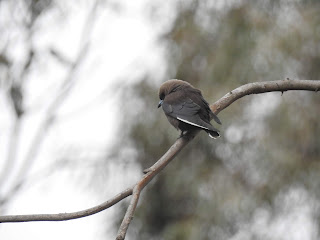Flocks of great tits and blue tits were omnipresent, as were Eurasian tree sparrows and house sparrows. Occasionally a flock of long-tailed tits would sweep through the garden and visit the feeder. Pine trees at the far end of the garden were visited by Eurasian jays and hawfinches, and a large tree in the centre of the garden was host to many short-toed treecreepers, Eurasian nuthatches, great spotted woodpeckers and once a single green woodpecker. A pair of blackbirds also inhabited the garden and, along with European robins, were often seen perched on the ground scratching through leaf litter. Once a Eurasian sparrowhawk flew through a nearby family's garden, but I was unable to get more than a glimpse of it.
Eurasian magpies and hooded crows were constantly flying overhead, along with wood pigeons. All 3 species were abundant throughout most of Berlin. A single carrion crow was seen once, but the crows in Berlin were almost entirely hooded.
The cemeteries in Berlin were all well-wooded and therefore great for birding. A visit to the cemetery in Karlshorst gave me good looks at many of the aforementioned species, along with my first Goldcrest, and some chaffinches.
Red squirrels were common in parkland, and particularly good views of some were had at the Schlossgarten Charlottenburg.
Anywhere there was water, black-headed gulls, mallards and Eurasian coots were abundant. In the skies above Berlin wheeled common gulls, Caspian gulls and Eurasian herring gulls, though often they were too distant to identify accurately. Occasionally I would be amazed by the sight of a Northern goshawk flying high overhead, sometimes being mobbed by crows.
BLUE TIT
Cyanistes caeruleus
GREAT TIT
Parus major
GREAT SPOTTED WOODPECKER
Dendrocopos major
LONG-TAILED TIT
Aegithalos caudatus
BLACKBIRD
Turdus merula
EURASIAN MAGPIE
Pica pica
EURASIAN JAY
Garrulus glandarius
EURASIAN NUTHATCH
Sitta europaea
SHORT-TOED TREECREEPER
Certhia brachydactyla
GREEN WOODPECKER
Picus viridis
HOODED CROW
Corvus cornix
GOLDCREST
Regulus regulus
HAWFINCH
Coccothraustes coccothraustes
EUROPEAN ROBIN
Erithacus rubecula
WOOD PIGEON
Columba palumbus
BLACK-HEADED GULL
Chroicocephalus ridibundus
RED SQUIRREL
Sciurus vulgaris


















































